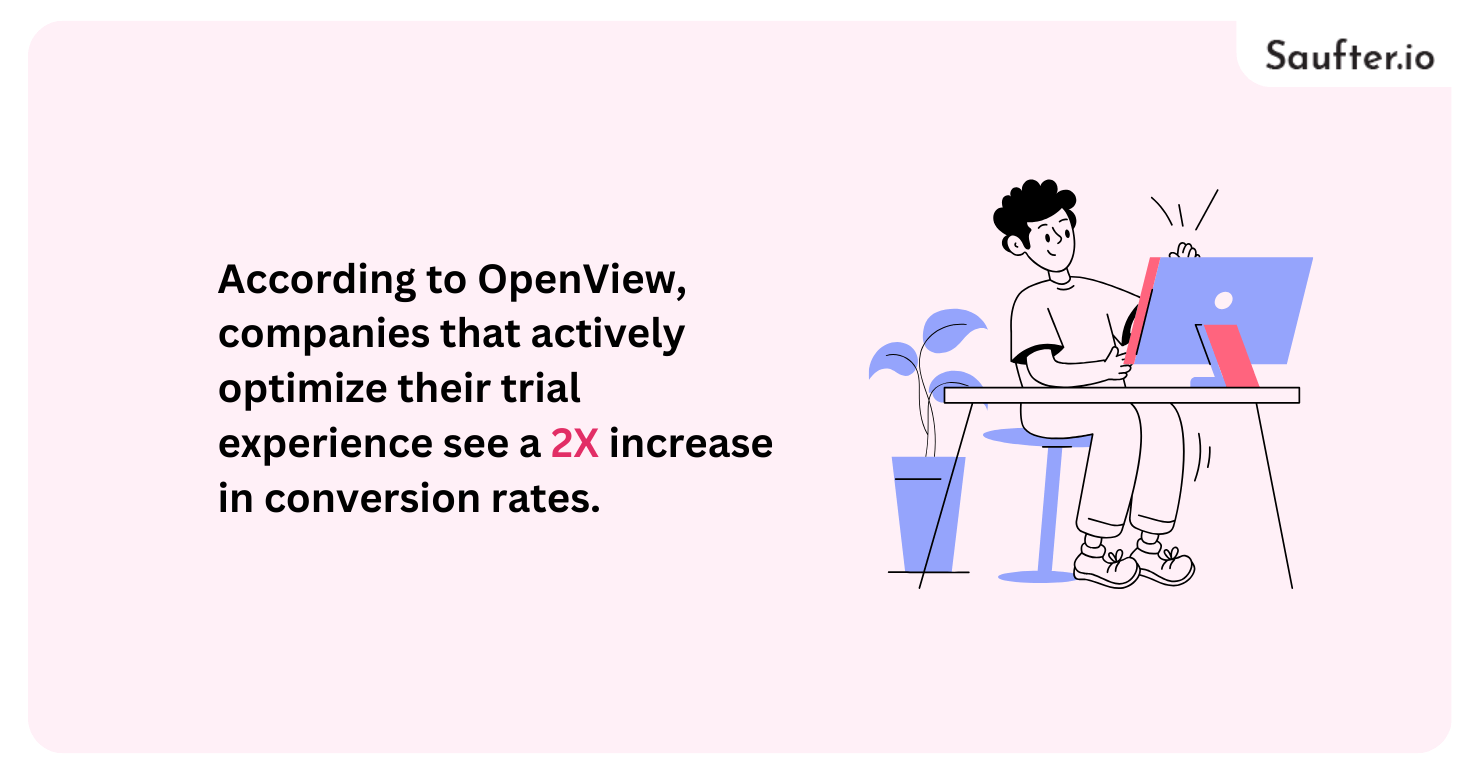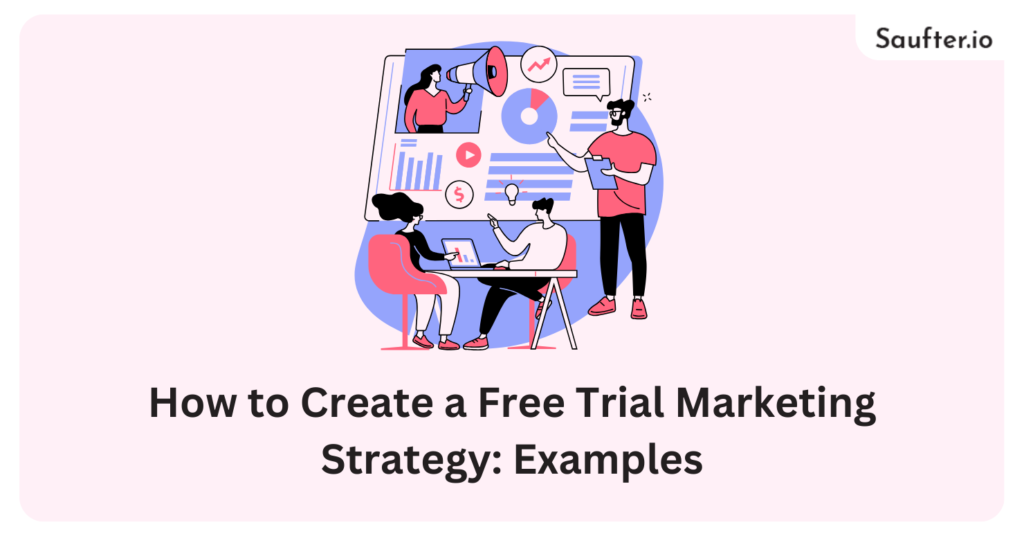Last Updated: December 2025
A well-crafted free trial marketing strategy can be a game-changer for SaaS and subscription-based businesses. According to a study by Totango, about 15% of opt-in free trial users convert to paying customers, while opt-out trials see a conversion rate of around 50%. However, the success of a free trial depends on more than just offering access to your product, it requires a strategic approach to maximize conversions.

This article will walk you through the essential components of a high-converting free trial marketing strategy, providing actionable insights and real-world free trial marketing examples to help you optimize your approach.
Why Free Trials Work

Free trials remove barriers to entry and allow potential customers to experience the value of your product firsthand. This approach helps businesses:
- Reduce hesitation in purchasing decisions
- Build trust and credibility
- Gather insights on customer behavior
- Increase long-term conversion rates
According to a SaaS Capital survey, companies with free trials grow 3X faster than those without them. But simply offering a trial isn’t enough, you need a strategic plan to engage, nurture, and convert users.
1. Define Your Free Trial Structure
The first step in crafting a free trial marketing strategy is deciding the type of trial that aligns with your business goals. Here are the main types:
Opt-in vs. Opt-out Trials
- Opt-in trials (no credit card required) have higher sign-up rates but lower conversion rates.
- Opt-out trials (credit card required) have fewer sign-ups but higher conversion rates.
A study by Recurly found that opt-out trials have an average conversion rate of 34%, while opt-in trials convert at 14%.
Freemium vs. Time-limited Trials
- Freemium: Users get limited features indefinitely, encouraging upgrades.
- Time-limited: Users get full access for a set period (e.g., 7, 14, or 30 days).
Example: Spotify’s freemium model allows users to access music with ads, while a 30-day free trial of Premium encourages paid upgrades.
2. Highlight Your Free Trial’s Perks
To boost sign-ups, you must communicate your free trial’s value. Some key incentives include:
- No credit card required (removes commitment fear)
- Exclusive features during the trial (increases perceived value)
- Guided onboarding and support (enhances user experience)
Example: Dropbox offers 2GB of free storage, enticing users to upgrade for additional space and features.
3. Create a Strong Onboarding Experience
A smooth onboarding experience is crucial for increasing trial-to-paid conversions. Research shows that 80% of users who fail to see immediate value during a trial never convert. Here’s how to optimize onboarding:
- Welcome emails: Send a personalized email with setup instructions.
- Guided tours: Use interactive walkthroughs to highlight key features.
- Progress tracking: Show users what they’ve completed and what’s next.
Example: Slack’s onboarding includes tooltips and pop-up tutorials to familiarize new users with its features quickly.
4. Implement an Effective Follow-Up Strategy
Many users forget about their free trials. A well-timed follow-up strategy can help re-engage them before the trial ends:
- Reminder emails: Send emails at 25%, 50%, and 75% of the trial period.
- Personalized outreach: Offer one-on-one demos for high-potential leads.
- Urgency tactics: Use limited-time discount offers for early sign-ups.
Example: HubSpot sends a sequence of emails providing valuable tips and case studies to keep users engaged throughout the trial.
5. Track Key Metrics and Optimize
Monitoring performance metrics is essential for refining your free trial marketing strategy. The most important metrics to track include:
- Trial activation rate (percentage of users who actively use the product)
- Engagement rate (how often users log in and interact with features)
- Conversion rate (percentage of trial users who become paying customers)
- Churn rate (percentage of users who cancel after the trial)
Using analytics tools like Baremetrics or Mixpanel can help businesses identify trends and improve their free trial marketing strategy.
6. Use Social Proof and Case Studies
Potential customers are more likely to commit when they see others benefiting from your product.
- Customer testimonials: Showcase positive reviews from past users.
- Case studies: Share success stories from customers who converted.
- User-generated content: Encourage trial users to share their experiences on social media.
Example: Grammarly uses testimonials and before-and-after writing samples to illustrate the benefits of upgrading to Premium.
7. Offer an Incentive to Convert
To encourage conversions, consider offering:
- Discounts on annual plans
- Bonus features for early sign-ups
- Personalized demos for undecided users
Example: Adobe Creative Cloud offers a special discount on its first-year subscription if users upgrade before their free trial expires.
8. Learn from Successful Free Trial Marketing Examples
Here are some real-world free trial marketing examples that highlight effective strategies:
Netflix (Opt-out Free Trial)
Netflix previously offered a 30-day free trial, requiring a credit card upfront. This opt-out model led to high conversions but was later discontinued in favor of other promotional offers.
Canva (Freemium + Trial Hybrid)
Canva allows free users to access basic design tools indefinitely while offering a 30-day trial for Pro features. This strategy provides users with enough value to encourage them to upgrade.
Zendesk (Personalized Follow-Ups)
Zendesk’s sales team reaches out personally to engaged trial users, offering one-on-one demos to help them understand the product’s full potential.
How to Convert Free Trial Users into Paying Customers

Converting free trial users into paying customers requires a strategic approach that guides users from initial activation to long-term commitment. Here are key strategies to improve conversion rates:
Focus on Early Activation
The first 24 to 48 hours of a trial are critical for setting the tone and driving user engagement. Users are more likely to convert if they experience value early in the trial period. To improve early activation:
- Send a welcome email – Include clear instructions and highlight the most valuable product features.
- Provide a product tour – Use interactive guides and tooltips to help users quickly understand core functions.
- Quick wins – Encourage users to complete a meaningful action, such as creating a project or sending a message, to help them experience immediate value.
For example, Slack’s interactive onboarding process helps users create channels and send messages within minutes, which increases early engagement and retention.
Engage Consistently During the Trial
Consistent engagement throughout the trial period helps maintain user interest and prevents drop-off. An effective engagement strategy includes:
- Mid-trial check-ins – Send automated emails at key points, such as 25%, 50%, and 75% of the trial period, to remind users of key features and benefits.
- In-app notifications – Highlight underutilized features and suggest ways to improve the user’s experience.
- Customer support availability – Provide easy access to help documentation and live support to address any issues promptly.
HubSpot’s email strategy includes personalized tips and case studies based on user behavior, encouraging users to explore the platform more fully.
Offer a Clear Upgrade Path
Make the transition from trial to paid subscription simple and straightforward.
- In-app upgrade prompts – Include a clear and visible “Upgrade Now” button.
- Limited-time incentives – Offer a small discount or bonus feature for early upgrades to create urgency.
- Flexible payment options – Provide monthly and annual payment plans to accommodate different user preferences.
Adobe Creative Cloud increases conversions by offering a 20% discount on annual plans if users upgrade before their trial ends.
A well-structured trial that focuses on early value, consistent engagement, and a clear upgrade path can significantly improve trial-to-paid conversion rates.
Trial Marketing Advantages and Disadvantages

A free trial run is an effective way to lure in potential buyers as the utility model of business can be used for SaaS and subscriptions. A free trial given by a competent provider is a huge help to IT specialists and it can be of utmost to the consumer. Not only it can be the right tool to find your customers but it also lets you visualize your product pipeline scenarios.
But sometimes it might push over the limits and you could find that you have a hard time making the decision.
Test, try, and understand the pros and cons of trial marketing can make businesses become more proficient in maximizing trial performance and also of long-term customer value.
Advantages of Trial Marketing
Reduces Purchase Risk
A free trial lowers the barrier to entry by allowing potential customers to experience the product without any financial commitment. This reduces the perceived risk and encourages users to explore the product’s value firsthand. By removing the pressure of an immediate purchase, businesses can attract a larger audience and increase the likelihood of conversion.
Makes Sales Easier Using Free Trials
A free trial provides immediate access to the sales product, thus bringing in more customers in comparison to other marketing tactics. People when able to afford to try products will also be more likely to buy them. Hence, it leads to a larger amount of leads and a potential sale of the product.
Enables Product-Led Growth
A fruitful trial introduces the user to the main value of the product, triggers self-discovery, and results in the growth of the product with no external influence. Clients who get good results while trying the trial period have a higher chance to join the paid plan and recommend the product to others. This way, a project is running which is fueled by the satisfaction of the customers.
Enables Data Collection and Customer Insights
Free trials allow businesses to gather valuable user data and behavior patterns. By monitoring how trial users interact with the product, companies can identify strengths and weaknesses, improve the user experience, and develop targeted marketing strategies. Free trial email marketing campaigns can be personalized based on user behavior to enhance engagement and increase conversions.
Disadvantages of Trial Marketing
High Operational Costs
Offering a free trial requires resources for customer support, infrastructure, and onboarding. If trial users fail to convert to paying customers, the costs of maintaining the trial infrastructure can outweigh the benefits. Additionally, the cost of acquiring trial users through advertising and free trial email marketing campaigns can reduce profitability.
Low Conversion Rates
Free trial periods can bring a large number of sign-ups, the rate of conversion of the users into purchasers is usually low, and then it deals with the extra step of making the free trial an opt-in one. The usual scenario is that the incomplete onboarding experience or the trial software value is not apparent, and then trial users may amazingly leave the product without upgrading.
Attracts Non-Qualified Leads
In contrast, using a free trial can draw users who do not like the product exactly but want to use it for free in the short term. These users do not buy, which ultimately may put the number of inactive users on the air and misguide the system.
Risk of Undervaluing the Product
When users have access to a product for free, then they are likely to underestimate its worth. This can make the product look less valuable and, therefore, the chances of leading users to a paid plan after the trial period ends can be reduced. Businesses should find the correct balance of value that will keep the users interested in the product.
Let us now introduce you to the best AI-based Email marketing tool- Saufter.io
Saufter: The Best AI-Based Email Marketing Tool

In the fast-paced world of digital marketing, Saufter AI stands out as the ultimate solution for businesses looking to optimize their email campaigns with cutting-edge artificial intelligence. Whether you run a SaaS platform, an e-commerce store, or any other online business, Saufter AI empowers you with data-driven insights and automation to enhance engagement and conversions.
Key Features
- Competitor Email Tracking: Automatically monitors and analyzes your competitors’ email campaigns, helping you stay ahead of the curve.
- User Behavior Analysis: Studies user interactions on your website and tracks their journey to generate targeted campaign suggestions.
- Personalized Email Campaigns: AI-driven personalization enhances email deliverability and engagement, ensuring your messages reach the right audience.
- Cohort-Based Suggestions: Segment users based on their engagement levels and behaviors to optimize campaign effectiveness.
Conclusion

A well-executed free trial marketing strategy can significantly boost conversions, but success depends on structure, onboarding, engagement, and follow-ups. Companies implementing strong free trial marketing examples like Netflix, Canva, and Zendesk, demonstrate how strategic planning leads to higher customer acquisition.
According to OpenView, companies that actively optimize their trial experience see a 2X increase in conversion rates. By leveraging these strategies, your business can maximize trial effectiveness and drive long-term revenue growth.
Ready to refine your free trial marketing strategy? Start implementing these techniques today and watch your conversions soar!
















